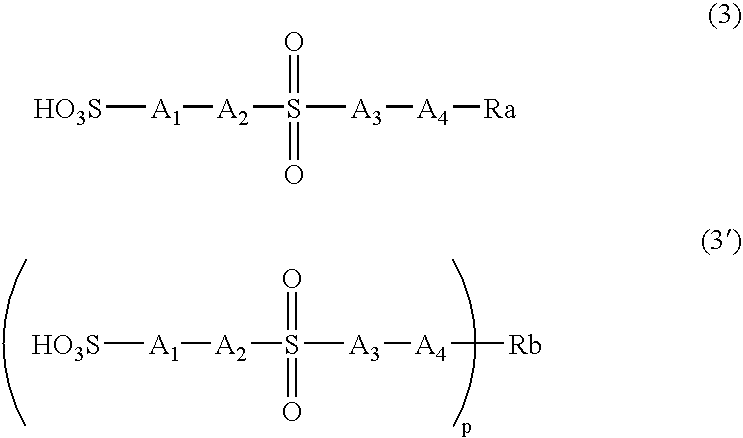Positive-working photosensitive composition and pattern forming method using the same
a technology of photosensitive composition and positive working, which is applied in the direction of photosensitive materials, instruments, photomechanical equipment, etc., can solve the problems of aggravating development defectiveness and deterioration of pattern formability, and reducing device yield, so as to improve the effect of mask error factor and improvement of development defectiveness
- Summary
- Abstract
- Description
- Claims
- Application Information
AI Technical Summary
Benefits of technology
Problems solved by technology
Method used
Image
Examples
synthesis example 1
Synthesis of Compound (A-1)
[0473] A mixture of 13.2 g (43.4 mmol) of ethylpropanyl pent fuorobenzenesulfonate, 12.1 g (65.1 mmol) of 1-dodecanol, 1.47 g (4.34 mmol) of tetrabutylammonium hydrogen sulfate, 130 mL of a 1 M water solution of sodium hydroxide and 130 mL of toluene was stirred for 12 hours at 70° C. The reaction solution thus obtained was rendered neutral by addition of dilute sulfuric acid, and the organic layer was dried with magnesium sulfate. After removal of the solvent, the residue was purified by column chromatography (SiO2, ethyl acetate / hexane=10 / 1) to give a colorless transparent oil (17.4 g). This oil was dissolved in 160 mL of acetonitrile, and thereto 5.93 g (39.6 mmol) of sodium iodide was added and stirred for 6 hours at room temperature. The reaction solution thus obtained was cooled by means of an ice bath. The solid matter thus deposited was filtered off, and then vacuum-dried to give 17.4 g (37 mmol, 85% yield) of 4-dodecyloxy-2,3,5,6-tetrafluorobenze...
synthesis example 3
Synthesis of Compound (II-1)
[0484] In a 2:1 (by mass) mixture of acetonitrile and distilled water, 3.3 g of triphenylsulfonium iodide was dissolved. To this solution, 1.5 g of silver acetate was added, and stirred for 30 minutes. The silver compound thus deposited was filtered out, and to the filtrate was added a solution prepared by dissolving 3.0 g of Compound (IA) illustrated below in a 2:1 (by mass) mixture of acetonitrile and distilled water. The reaction solution was concentrated, and dissolved in 200 ml of chloroform. The resulting solution was washed with successive distilled water, an aqueous solution of ammonium chloride, and water. The organic phase was passed through a 0.1-μm polyfluorotetraethylene filter, and concentrated to give 4.2 g of Compound II-1.
[0485]1H-NMR (300 MHz, CHCl3) δ 7.6-7.8 (m, 15H)
[0486]19F-NMR (300 MHz, CHCl3) δ 115.59 (4F), δ 122.29 (2F)
[0487] In accordance with the synthesis methods mentioned above, photo-acid generators used in the following...
PUM
| Property | Measurement | Unit |
|---|---|---|
| wavelengths | aaaaa | aaaaa |
| wavelengths | aaaaa | aaaaa |
| width | aaaaa | aaaaa |
Abstract
Description
Claims
Application Information
 Login to View More
Login to View More - R&D
- Intellectual Property
- Life Sciences
- Materials
- Tech Scout
- Unparalleled Data Quality
- Higher Quality Content
- 60% Fewer Hallucinations
Browse by: Latest US Patents, China's latest patents, Technical Efficacy Thesaurus, Application Domain, Technology Topic, Popular Technical Reports.
© 2025 PatSnap. All rights reserved.Legal|Privacy policy|Modern Slavery Act Transparency Statement|Sitemap|About US| Contact US: help@patsnap.com



